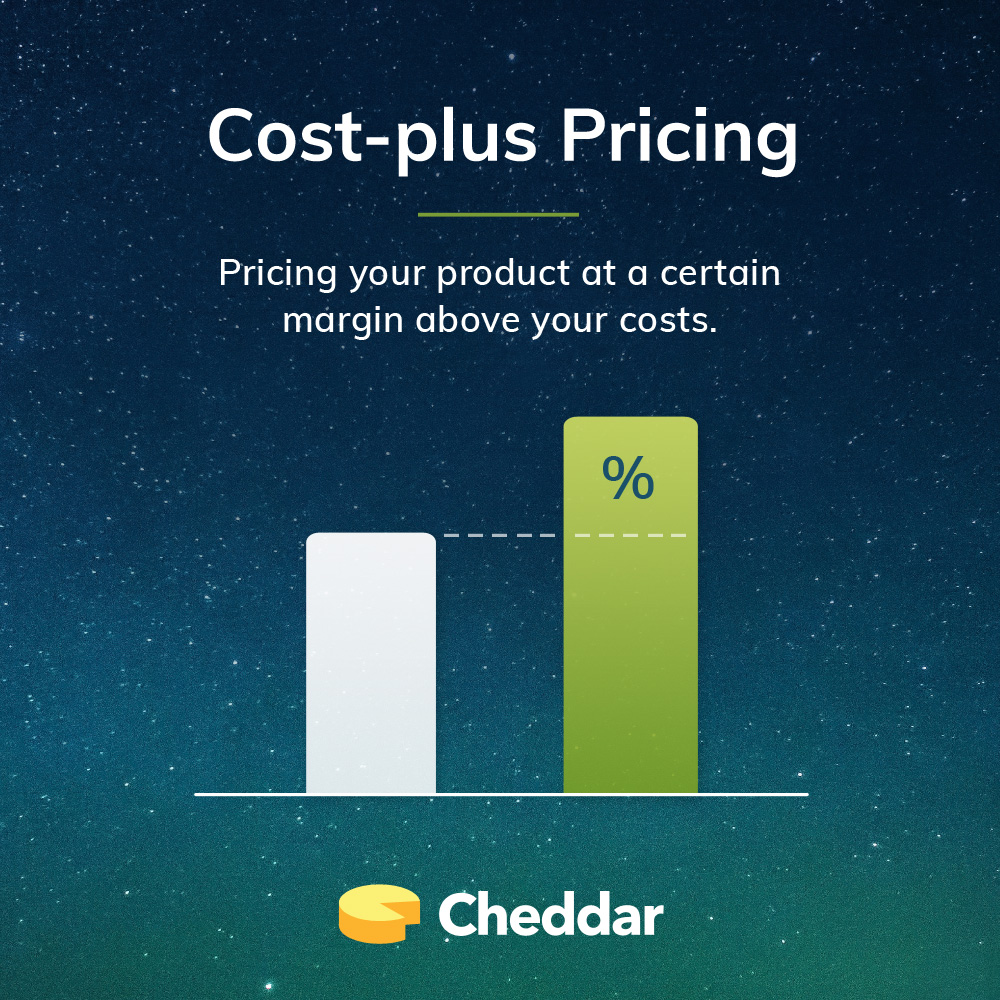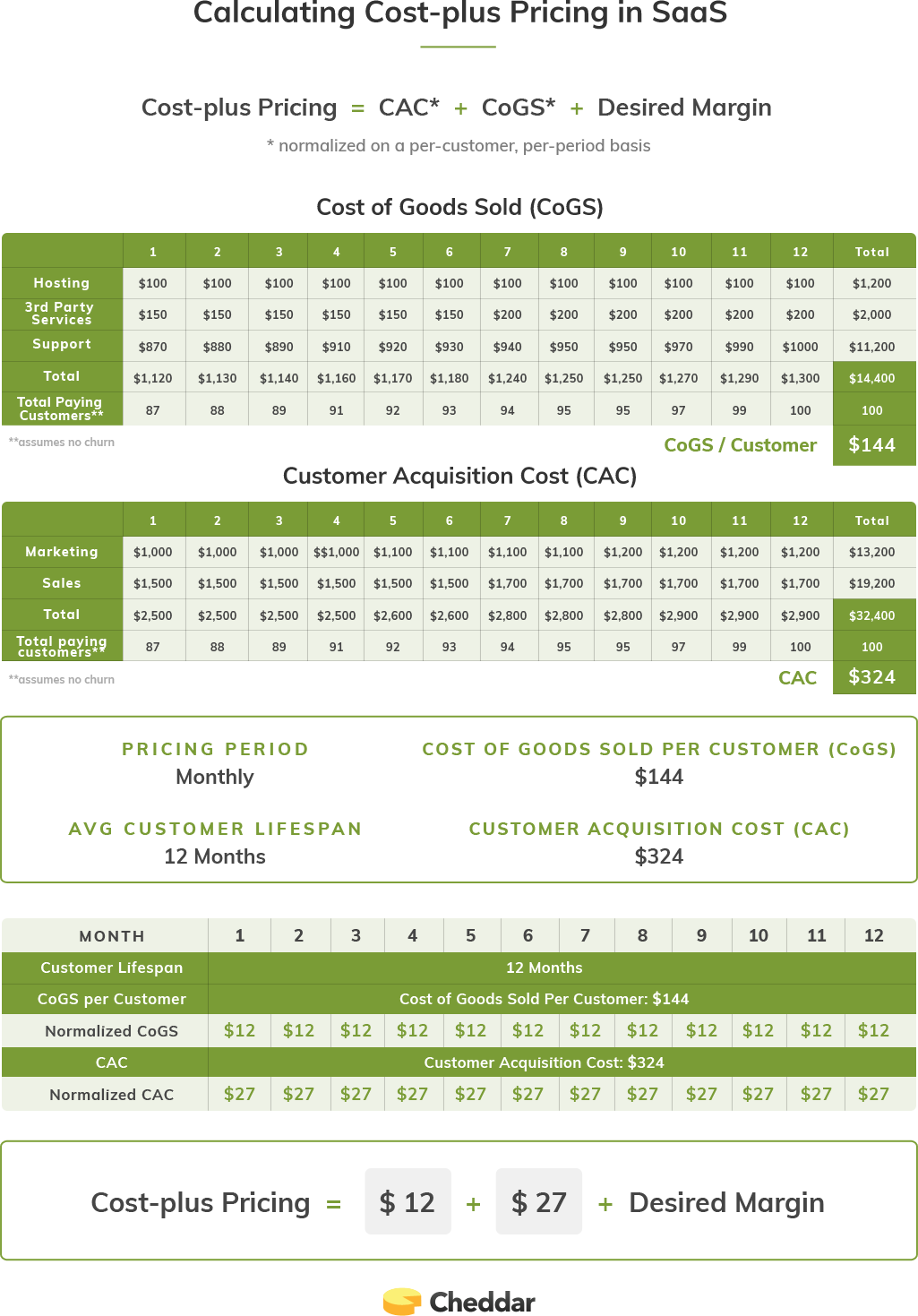October 2
Why a Cost Plus Pricing Strategy is Still Important in SaaS

People typically dismiss the cost-plus pricing strategy in SaaS, but we believe that’s a dangerous mistake.
Critics argue that using a cost-plus pricing strategy “leaves money on the table” because software typically sells with higher value-based pricing, producing a healthy 60-80% gross margin. Additionally, cost-plus pricing doesn’t require that you talk to any customers, which is generally frowned upon in any business.
Yet, even in the software industry, if your unit cost of doing business is higher than customers’ perceived value, you won’t be doing business for long. Hence, it’s important to understand the dynamics of cost-plus pricing in SaaS.
What is Cost-plus Pricing?
By definition, cost-plus pricing means you calculate your business’s costs and add a desired markup percentage to get to your product’s selling price. It’s essential to any pricing strategy because your costs dictate the lowest possible price you can charge and still operate profitably.

When people think about a cost-plus pricing method they tend to only think about their cost of goods sold (CoGS). Things like cloud infrastructure, customer support, software engineering, and other product costs are typical SaaS CoGS. Having a founding team that has worked with 20+ SaaS startups, we’ve learned that on average, CoGS typically accounts for around 30% of revenue. If your business requires physical products, hardware, or custom development, your CoGS will likely be higher.
Calculating cost-plus pricing using only CoGS, however, provides an inaccurate benchmark, as you would ignore sales and marketing costs. Moreover, hidden among these operating expenses is one of the most important SaaS metrics for many businesses: your customer acquisition cost (CAC).

Calculating Customer Acquisition Cost (And Other Important Cost-Plus Metrics)
Your customer acquisition cost is the average amount of money you have to spend to gain a new paying customer. It’s one of the most critical SaaS metrics because it’s usually higher than CoGS per unit and can have a big impact on your cash flow.
To calculate CAC:
- Determine your target months to recover, the period of time that you’d like to recoup your CAC.
- Sum your total sales and marketing expenses during that period, including your staff (marketing and sales team), advertising expenses, and overhead.
- Divide that number by the number of customers you acquired during that time period.

Voilà, you have your cost of customer acquisition. When combined with your average customer lifetime value (LTV: CAC), you can get a good idea of the health of your business. The higher the ratio, the quicker you can grow and more profitable you can become. Typically, a healthy Saas company has a LTV:CAC ratio of 3:1.
However, you need to make your CAC and CoGS the most relevant in the context of your pricing. This can be done by normalizing them on a per-customer per-period basis using your target months to recover. Normalization will help you understand how much money you should allocate to each billing cycle.
For example, let’s say you sell your product on a monthly basis and you’ve determined the following:
- CAC: $324
- CoGS per customer: $144
- Target months to recover: 12 months
You’d need to allocate:
- $27 ($324/12 months) of CAC
- $12 ($144/12 months) of CoGS
to your cost-plus pricing each month to account for what you’re spending to acquire and provide services to that customer.

How Acquisition Strategy Affects Cost-Plus Pricing
How you choose to sell your product dramatically influences your customer acquisition costs and as a result, your pricing decisions.
We’ve talked about how your acquisition strategy influences your SaaS pricing strategy before, but it’s worth diving into again. Simply put, selling via personalized, relationship sales model will lead to a relatively higher CAC and justify a higher price. Contrarily, selling via a scalable, self-service model will lead to a relatively low CAC and justify a lower price. Neither approach guarantees a healthier LTV: CAC ratio, however.
Relationship Sales as a customer acquisition strategy:
Relationship sales involve focusing more resources on your sales and lead-generation team. If you use a relationship sales approach to acquiring customers, you should consider the time and money spent on:
- Researching leads
- Making calls
- Building relationships with potential customers
- Giving demos
- Traveling to meetings
The total costs of all of these engagements can easily cost upwards of $2,000-$3,000 per potential customer.
With this highly personalized approach, companies acquiring customers through relationship sales often charge at least $1,000-$1,500 per month. Depending on the product’s churn rate, conversion rates, and customer lifetime value, some companies can get away with charging less.
While relationship sales tend to lead to a higher CAC, they also let your charge much more for your product.
Self-service as a customer acquisition strategy:
Self-service or self-signup, as a SaaS customer acquisition strategy, is often seen in the same industries as relationship sales. The price of their software, however, is usually much lower because of their lower relative customer acquisition cost.
Self-service SaaS involves focusing more resources on your marketing team, content, and advertising. If you use a self-service approach to acquiring customers, you should consider the marketing and labor costs associated with:
- Digital advertising
- Creating marketing assets such as ebooks, blogs, videos, and podcasts
- Supporting customers on free trial or freemium accounts
- Conducting webinars, attending events, traveling to speak
With this content and advertising-driven approach, some SaaS companies could charge as low as $5 or $10 per month. For this to work, they expect to acquire relatively more customers—“flies” or “mice”—through their marketing efforts. Similarly, if they plan to acquire relatively fewer customers, they’ll likely need to charge more, starting at $25-$100 per month.
While self-signup companies benefit from a relatively low CAC, they also tend to charge less than their relationship sales counterparts.

Cost-plus Pricing Becomes Vital As You Grow
While helpful to understand, cost-plus pricing won’t necessarily represent how you’ll price your product. Nor does it constitute a holistic SaaS pricing strategy. You still need to consider a customer’s willingness to pay, your value to a customer, as well as competitors’ pricing.
However, cost-plus pricing does help you understand your business’s true costs so you can operate profitably in the future. It will also be helpful as your customer acquisition strategy changes and grows.
A new product or service has an advantage in that they can price based on value—and they should to maximize their revenue. Unfortunately, that’s a short-term pricing strategy. If you have high profit margins, you’ll likely see competitors enter the market. This limits what you can charge unless you maintain a strong product differentiation strategy, healthy level of product loyalty, and high customer value.
Curious to learn more about cost-plus, value-based, competitive, and survey-based SaaS pricing strategies? Sign up for our Pricing Bootcamp. Over the free email course, you’ll learn how these strategies work together, receive templates, example spreadsheets, and additional information that will walk you through transforming pricing into a competitive advantage.
About Cheddar
Billing built for developers. Cheddar is a usage-based billing platform that helps you track customer activity, iterate your pricing, and optimize your revenue so you can focus on building awesome products, not billing for them. Made with ❤ from the Midwest.